Farmhouse Studio Genetics showcase multi-gland trichomes on cannabis
SHWALE of Farmhouse Studio Genetics, a cannabis breeder and photographer, has revealed stunning shots of multi-gland trichome heads discovered on certain cannabis cultivars. Called abscission zones, these multiheaded trichomes are extra shiny because they reflect/refract light differently and are a new type of trichome under the bulbous trichome aka glandular trichome class. Not surprisingly, they also have larger average micron sizes. Multi-gland trichomes are known to exist on tomato plants, salvia plants, monkeyflower plants, among others. Now they’ve been proven to exist on cannabis, too. Do note that there’s also branched trikes and ruptured trichome heads which are different than a bonafide mutant multi-gland trichome as demonstrated. Of course, over time, many cannabis breeders have reported seeing multi-gland and otherwise nontraditional trichomes on other cultivars before. Seeds of Kismet showed me some pictures of twoheaded trichomes on a live Blueberry 98 plant and the below Darkwood cultivar – ones where fallen heads weren’t a probable cause of extra large comboheads.
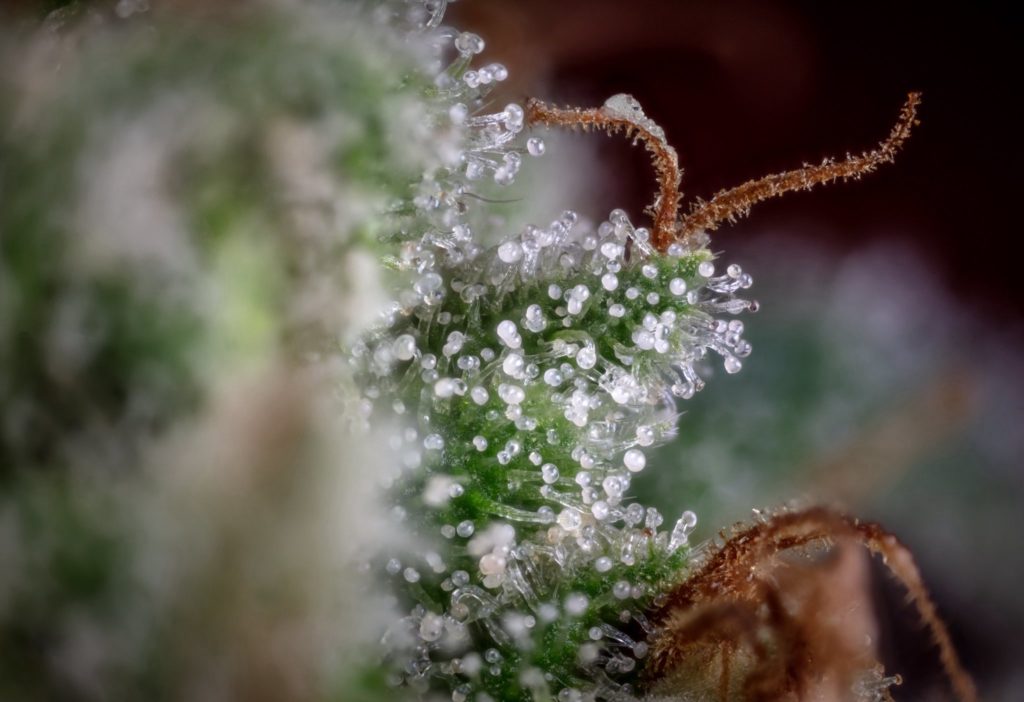
All this to say that nobody is creating new traits in cannabis that mother nature didn’t make herself, just finding them, isolating them, and highlighting them. Farmhouse Studio Genetics had to have got the trait from somewhere to bring out from somewhere in the genetic stock that’s floating around ‘murrica. Thanks to that – we have these beautiful shots of Sugar Coat as the first cultivar SHWALE noticed with the multi-gland trichome heads. Frankly, the newer, more worked cultivars have even better shots of clear multi-gland trichomes.
We already know that trichome head size as well as type of trichomes and their distribution are all cultivar dependent (read: genetics dependent). Here’s the story of how a team with a dream used the scientific method to move cannabis breeding forward. Hash heads rejoice.
Multi-gland trichome heads photographed by SHWALE in 2020
I reached out to SHWALE and got some quick answers to my questions. He identified Sugar Coat as the first cultivar he bred that he identified as showing multi-gland trichome heads, and emphasized that multi-gland trichome heads were the result of breeding to bring out the gland abscission trait. SHWALE commented:
“We’ve been selecting for weakneck genetics since 2020. Sugar Coat was the first, whole glands will just pop off from a slight bump. This is great for hash. Been backcrossing and out in a technique i call basketweaving for years to bring the whole gland abscission trait along. Now 4 generations later we’ve identified that glands are growing several new glands “abscission zones” off the main gland. This is an adaptation to deal with pests but again is great for hash. Still has the whole gland abscission trait.”
SHWALE continued, emphasizing the layman’s understanding of the cannabis breeding breakthrough at hand:
“Pretty much we’re turning cannabis trichomes into tomato trichomes with multiple glands growing off of one stalk. “
How’d they do it? A keen eye, loupes, microscopes, and a desire to make better cultivars for hash.
“This was all possible through the use of microscopes with calibrated measurements and research into scientific articles about trichomes of all forms. We’re hash breeders that use scientific methods and equipment. The High Times article will help lay a foundation for our breeding selection for larger glands too.”
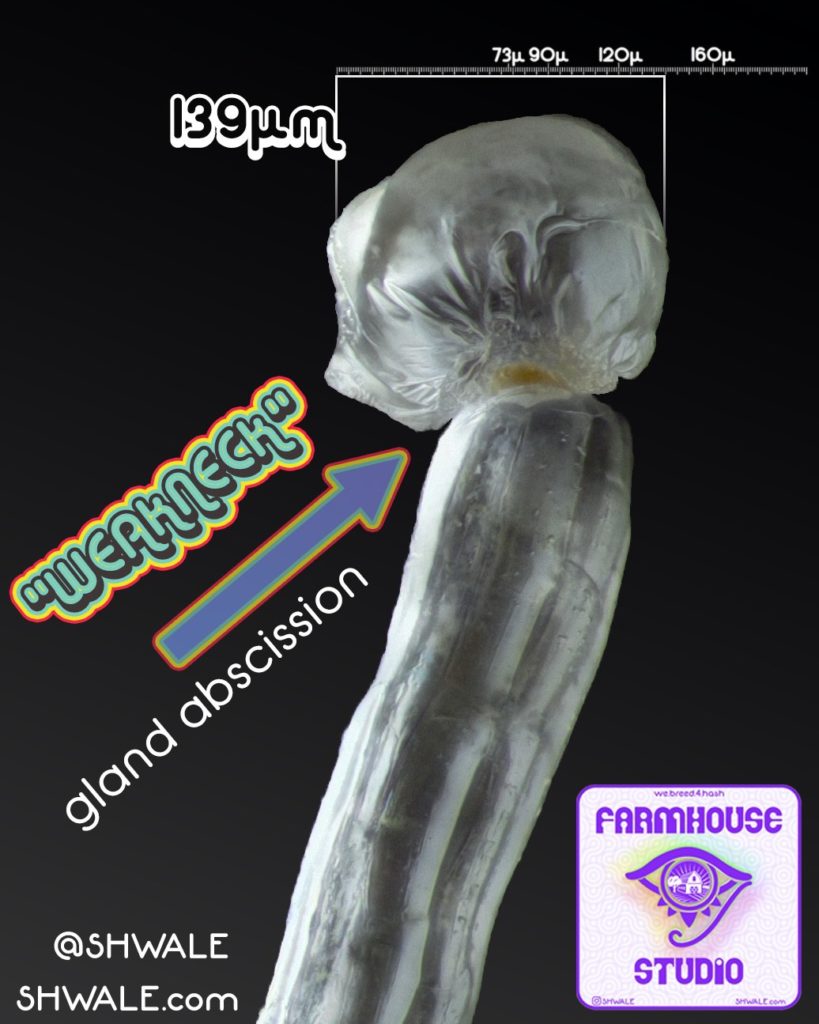
SHWALE is referring to a High Times article from 2022 where he got the headnodder from Nikka T for coining the term “weak neck traits” and also a forthcoming article about more recent hash breeding. How exactly is science being used in this process besides dank macro photography? SHWALE showed me a picture and described how they use an app to count trichome heads:
“This is how we count glands “count things” app rebar setting. And factor Total Gland Length which is number of glands x average gland size. Fixed area of 5:1 or 5x magnification.
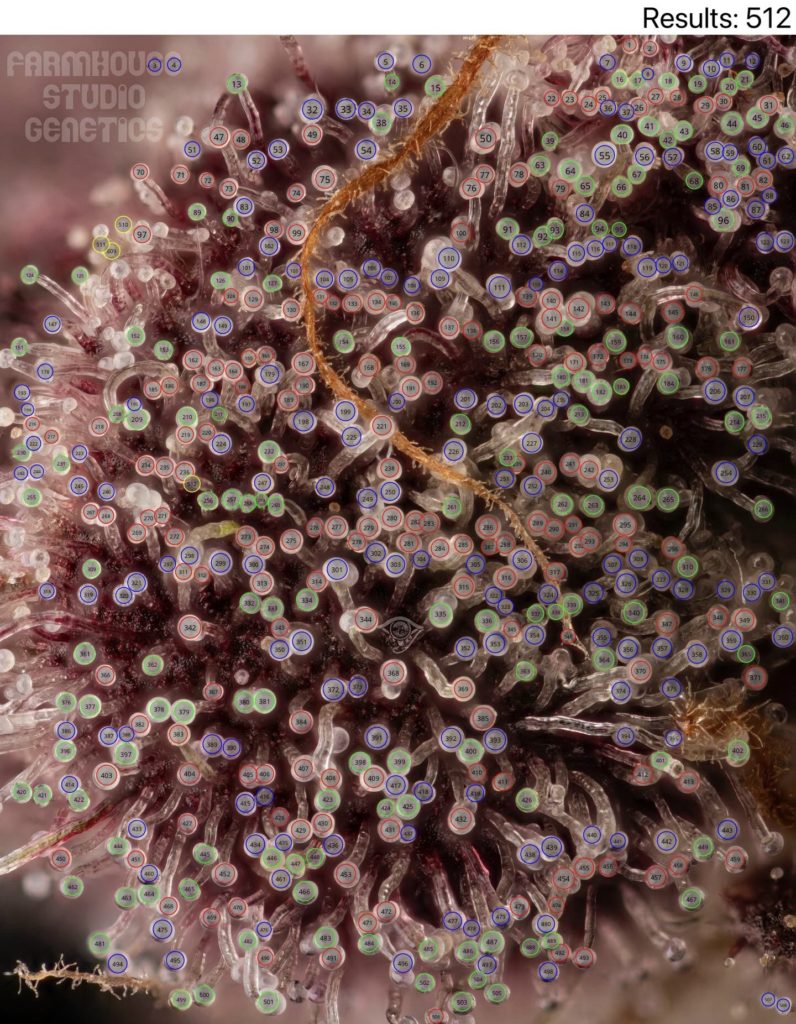
Note, it counts heads not glands!
Sugar Coat – the first cultivar observed with the gland abscission trait
Like countless cannabis culture shaking discoveries in the past, this particular discovery happened by chance while inspecting the plants. SHWALE walked me through the 2020 discovery and how to him, it was visibly different than clumped fallen trichome heads or burst and rehardened trichome heads typical of some cultivars:
“When I first discovered the triple gland one stalk on Sugar Coat, I was just checking the garden out by eye. Noticed this huge gland waving at me. Got a loupe and noticed it was different. So I cut the flower off immediately and took it to the studio. Boom 3 glands one stalk confirmed. At first I tried to explain it as broken fallen glands. But it didn’t really add up. Two glands fell perfectly and also have different stages of senesce?.. Usually you can see the stipe cells under the secretory cells on a gland that has fallen off and stuck itself somewhere new. I wasn’t seeing that. But I knew this one photo wasn’t enough evidence that we did a thing. “
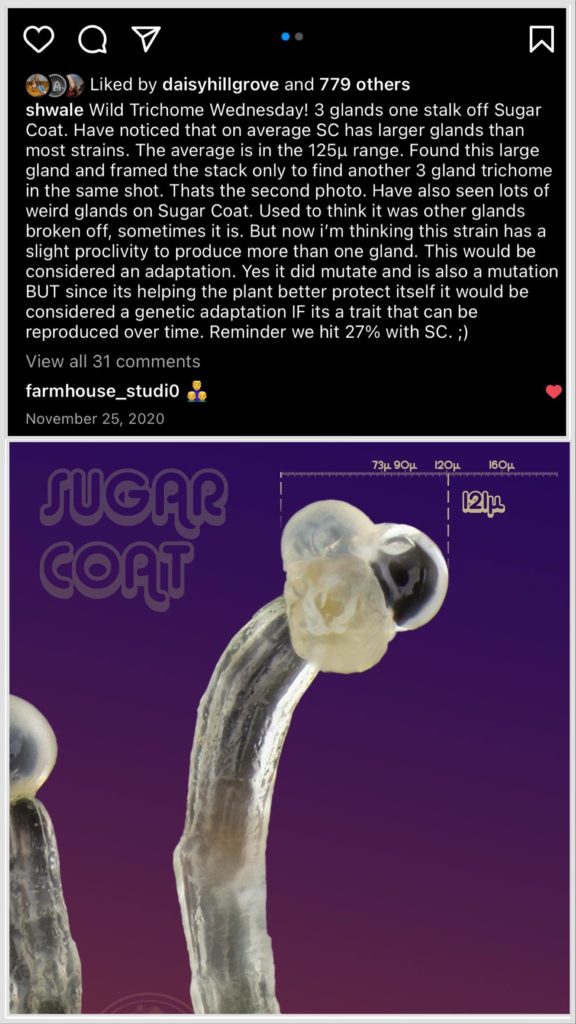
The discovery lay unpublicized for some time, until the multi-head trait popped up in two new cultivars. One called JOMO – is a GMO x Sugar Shack cross which has Sugar Coat genetics via the Sugar Shack father. The other, called Diamond Glands, is a cross of JOMO x Sugar Coat. SHWALE described:
“Later in the JOMO line I noticed the same large glands on JOMO the HUTT by eye just walking around. That’s how big they are you can plainly see somethings up with your naked eye. Again, I took the flower into the studio immediately, didn’t have to call a photographer up since I am one.. again the JOMO the HUTT glands showed several forms of micro-mutations. Abscissions, gland widening and splitting in the middle similar to an extra leaf in a diner table. Stretched wide. But when I noticed the exact same abscission zone or extra gland on top of the gland in the same spot on both Diamond Glands and JOMO the HUTT, I realized we were changing the way glands grow through selective breeding and getting a close look. “
SHWALE says he doesn’t mind if this trait gets out there and improves the yield across the board but Farmhouse Studio Genetics wasn’t quite ready to drop Diamond Glands yet.
“We’ve been kinda used as a stepping stone for breeders since we release regs only & we do encourage breeding with our work. We know once it hits the streets it’s the street’s – no take backs. So we held Diamond Glands back since it was showing double gland adaptations so much.”
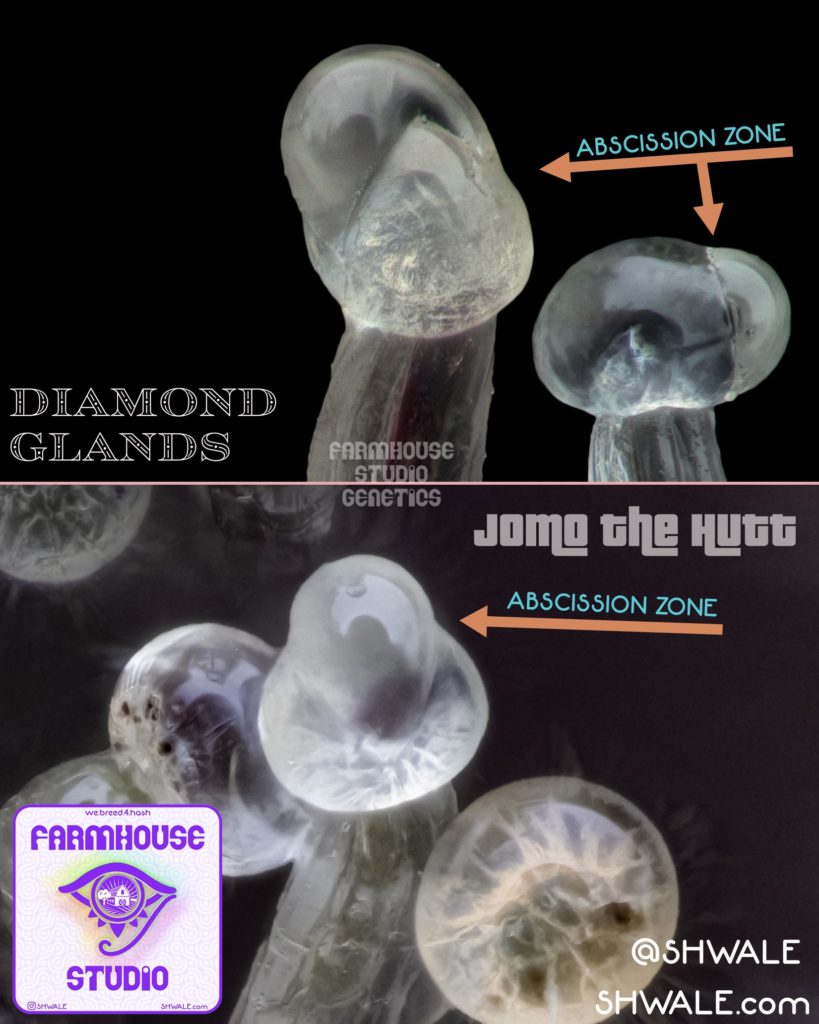
Why these multi-gland trichomes aren’t just ruptured resin heads
Despite having been sure that this was something observable that was bred for, SHWALE says he has been dealing with pushback from those that posit that some of these seemingly multi-glandular trichomes could just be the result of oil bursting and recrusting on singular heads. SHWALE responded to the pushback with a single emoji: 🏀.
“Then we started to get some pushback and I was having to defend our findings. It’s hard to find any info about extra oil even secreted onto the outside of the gland. But I did find one article with a lot of info. But none of their SEM photos were looking the same or even similar. So I remembered that tomato trichomes will split into 4 glands with one stalk sometimes.”
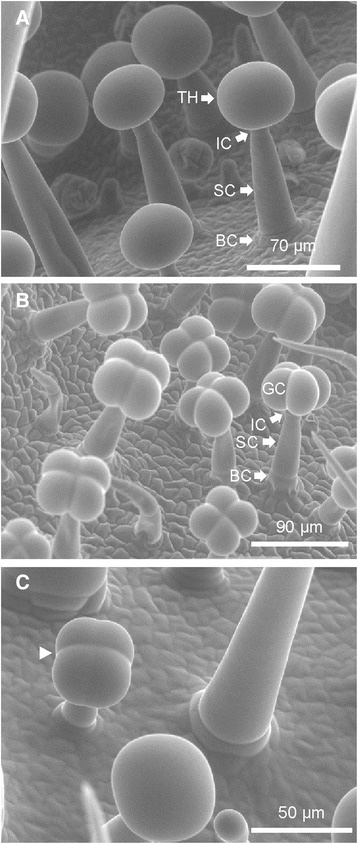
As shown from electron microscope photos from The development of type VI glandular trichomes in the cultivated tomato Solanum lycopersicum and a related wild species S. habrochaites, tomatoes aren’t the only plants with multi-gland trichomes – not by a long shot. SHWALE drew on his experience photographing trichome heads of all types (including ruptured ones) over time to explain why he feels all of the observed heads are pure mutations and couldn’t physically be a ruptured resin head:
“Think of the gland as a thick rubber ball with molasses inside. Also there is a tube keeping the ball at pressure by supplying the ingredients to make molasses. If the rubber ball is ruptured it will deflate and look wrinkled. A plump smooth ball with extra growths is proof an inner gland & outer cuticle wall must be present.. keeping the main ball or gland plump and smooth. Also the taut rounded geometrical shape similar to a helmet or turtle shell sometimes with pointed angles, of the extra glands or partial show the presence of a cuticle.”
At the end of the day, SHWALE feels that the pictures speak for themselves.
“Oil open to the air has tension and can form balls, but only for so long. It gets pulled down by gravity looking like melted wax. I can point to scientific articles that show this, they also show the main gland very deflated and wrinkled from actual ruptures. Glands can’t seal themselves and re-plump or “rupture twice.” Imagine the rubber ball sealing itself with hard molasses.. hard enough to rupture the ball again!? Common sense tells us it would rupture out of the original weak point IF it was a double rupture. We’ve shown terpenes sitting on top of the 2nd gland. If it was a rupture, terpenes wouldn’t separate from themselves. We’ve even been able to point out the wrinkles and outer cuticle wall on the 2nd gland growths.”
There is evidence of multi-gland trichomes on other plants such as monkeyflower which can be seen in studies such as the following: Convergence of glandular trichome morphology and chemistry in two montane monkeyflower (Mimulus, Phrymaceae) species. SHWALE continued:
“Double gland or multi-gland trichomes are not new. Tobacco has glands that grow upward. Salvia is closely related to cannabis & has double gland stalked trichomes that look very similar. Monkeyflower has stalked double glands that also look similar, growing upward. Even in cannabis the bulbous gland has been identified to be complex sometimes and have multiple glands of various ripeness.”
How do multi-gland trichomes form? Nobody actually knows yet.
How the double or multi gland trichomes form and whether the different heads deserve to be called glands or abscission zones – and how they look after they form – is clearly still being debated and won’t be laid to rest until a peer reviewed scientific study is completed.
After all, the process of ruptured trichome heads forming seemingly second and even third heads is something that has been demonstrated, though what that looks like on dead flower is unclear. Take this video by Zoom Gardens of a trichome head being pierced by a needle and then forming two new heads as a result as an example. What’s clear to me at least is that a trichome observed with multiple heads could have multiple origins – ranging from catching a fallen head from another single gland trichome to maybe ruptures to verified mutation and we will need a lot more observers to narrow down which one is which.
I’m personally curious about stuff like the cuticle to oil ratio on ruptured glands vs mutated glands vs normal glands. I reiterate my humble plea: It’d be nice if some trichome scientists could publish a peer reviewed study on this. Til’ then, I’m of the opinion that mutated and ruptured heads both exist and both would be traits that could be brought out with Mendelian genetics.
Trust that studies on glandular trichome morphology and chemical composition in cannabis are ongoing and forthcoming, and I’d like to posit that any researchers in this space should reach out to both SHWALE and Zoom Gardens with questions or to get some of these genetics to grow in a university research lab themselves. Yes, that’s right around the corner, too.
So do ruptured heads or mutated heads shine more?
A new breakthrough in bag appeal of cannabis trichomes…
Turns out… SHWALE has noted that abscission zones cause multi gland trichome heads (read: a single trichome’s heads – MULTIPLE) to refract light differently. After all, that’s how the Diamond Glands cultivar got its name:
“ […] I could see large glistening glands on some of the plants from the DG line. The extra glands or partial gland abscission act a lot like a [cut] diamond with many facets. Giving the appearance of glistening more than normal. I mean talk about actual bag appeal.”
SHWALE commented more about the bag appeal of this new identified and worked for genetic trait… and that it translates to better yield in hash, too:
“This is real deal bag appeal not long stalks or just purples making the glands stand out more. Glands that are larger and have more cavities to hold secondary metabolites. Exactly what we set out to do. Just amazing and such an aw-ha moment for us.”
While I’m focused on the realtime cannabis breeding efforts – it’s also worth noting how this type of new cannabis genetic trait might matter to the end customer or consumer even beyond something as mundane and far removed from normal consumption patterns as hash yields. SHWALE continued by emphasizing that this selection just highlights something that the cannabis plant naturally evolved to do:
“Looking into that more I found [the article authors] calling the 2nd glands abscission zones. I thought this phrase is confusing with the whole gland abscission zone at the base of the gland and the stalk. But they call the extra gland growth an abscission zone because it too can easily detach from the main gland. This is an adaptation to deal with pests just like whole gland abscission. They act the same because the plant thinks I can better protect myself if I have many glands that will easily pop off and onto the pests. Or in our case into your eyes.”
That’s right… read that back until it sinks in… To the plant, we are the pests. SHWALE tied it all together with an anecdote I kind of want to experience at least once… but probably just once.
“Anybody that’s grown our genetics knows not to stay under the plants as you pull leaves or trichomes will straight fall into your eyes. It burns. This is why these traits are great for hash. Partial gland abscission or extra glands that break off easily and whole gland abscission means a gentle wash for only a few minutes and the hash water is milky. Less stalks per glands is gonna make the hash cleaner and more melty.”
Thanks for sticking to the end and learning about abscission zones aka the technical term for the n-th heads on a multi-gland trichome. There are several types of trichomes, and multiple types of trichome heads. As this science develops, we’ll try to keep y’all appraised.
Founder of The Highest Critic
Unpaid /r/trees mod
Certified Ganjier
Kine bud enthusiast

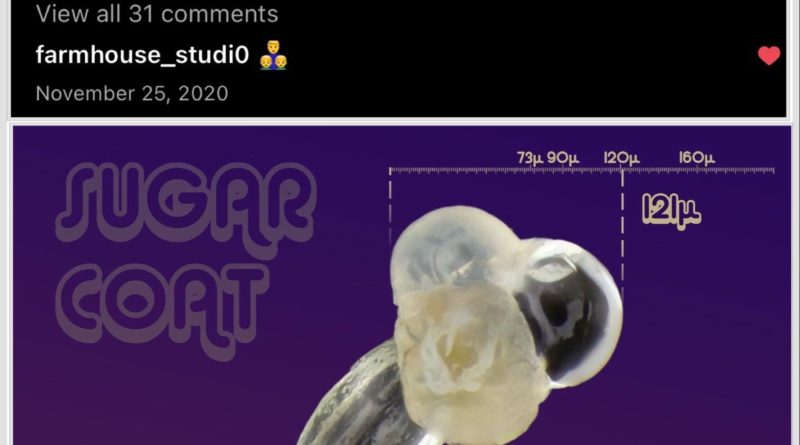
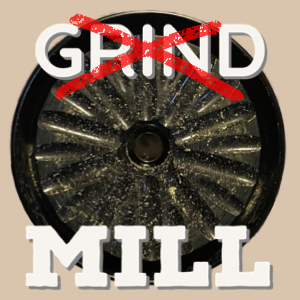
Amazing article & interview! Very Thorough and Well Thought Out.